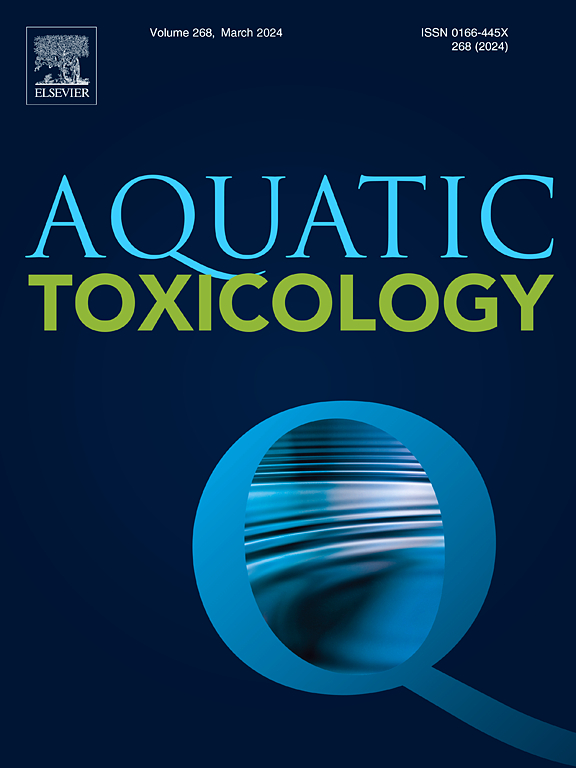Protective role of melatonin against radiation-induced disruptions in behavior rhythm of zebrafish (danio rerio)
IF 4.1
2区 环境科学与生态学
Q1 MARINE & FRESHWATER BIOLOGY
引用次数: 0
Abstract
Ionizing radiation, as an increasingly serious environmental pollutant, has aroused widespread public concern. Melatonin, as an indole heterocyclic compound, is known to have anti-inflammatory and antioxidant effects. However, few studies have considered the comprehensive impact of melatonin on radiation damage. In this study, we used zebrafish as experimental materials and employed methods such as acridine orange staining, enzyme-linked immunosorbent assay (ELISA), video tracking for automated behavior analysis, microscope imaging, and real-time fluorescence quantitative analysis. Zebrafish embryos at 2 h post-fertilization (hpf) were treated under four different experimental conditions to assess their growth, development, and metabolic consequences. Our findings indicate that 0.10 Gy gamma radiation significantly augments body length, eye area, spine width, and tail fin length in zebrafish, along with a marked increase in oxidative stress (P < 0.05). Moreover, it enhances cumulative swimming distance, time, and average speed, suggesting elevated activity levels. We observed circadian rhythm phase shifts, peak increases, and cycle shortening, accompanied by abnormal expression of genes pivotal to biological rhythms, exercise, melatonin synthesis, apoptosis/anti-apoptosis, and oxidation/antioxidant balance. The inclusion of melatonin (1 × 10-5 mol/L MLT) ameliorated these radiation-induced anomalies, while its independent effect on zebrafish was negligible. Melatonin can regulate oxidative stress responses, hinders apoptosis responses, and reprogramming the expression of rhythm-related genes in zebrafish embryos after reprogramming radiation stimulation. Overall, our research highlights melatonin's critical role in countering the biological damage inflicted by gamma radiation, proposing its potential as a therapeutic agent in radiation protection.
褪黑激素对辐射引起的斑马鱼行为节律紊乱的保护作用
电离辐射作为一种日益严重的环境污染物,引起了公众的广泛关注。褪黑素作为一种吲哚杂环化合物,具有抗炎和抗氧化作用。然而,很少有研究考虑褪黑激素对辐射损伤的综合影响。本研究以斑马鱼为实验材料,采用吖啶橙染色、酶联免疫吸附试验(ELISA)、视频追踪自动行为分析、显微镜成像和实时荧光定量分析等方法。在四种不同的实验条件下处理受精后 2 小时(hpf)的斑马鱼胚胎,以评估其生长、发育和代谢后果。我们的研究结果表明,0.10 Gy 伽马射线会显著增加斑马鱼的体长、眼球面积、脊柱宽度和尾鳍长度,同时氧化应激也会明显增加(P < 0.05)。此外,它还能增加累积游动距离、时间和平均速度,表明活动水平提高。我们观察到昼夜节律相位移动、峰值增加和周期缩短,并伴随着生物节律、运动、褪黑激素合成、凋亡/抗凋亡和氧化/抗氧化平衡等关键基因的异常表达。加入褪黑素(1 × 10-5 mol/L MLT)可改善这些辐射诱导的异常现象,而褪黑素对斑马鱼的独立影响可以忽略不计。褪黑激素可以调节氧化应激反应、阻碍细胞凋亡反应以及重编程辐射刺激后斑马鱼胚胎中节律相关基因的表达。总之,我们的研究强调了褪黑激素在对抗伽马射线造成的生物损伤方面的关键作用,并提出了其作为辐射防护治疗剂的潜力。
本文章由计算机程序翻译,如有差异,请以英文原文为准。
求助全文
约1分钟内获得全文
求助全文
来源期刊

Aquatic Toxicology
环境科学-毒理学
CiteScore
7.10
自引率
4.40%
发文量
250
审稿时长
56 days
期刊介绍:
Aquatic Toxicology publishes significant contributions that increase the understanding of the impact of harmful substances (including natural and synthetic chemicals) on aquatic organisms and ecosystems.
Aquatic Toxicology considers both laboratory and field studies with a focus on marine/ freshwater environments. We strive to attract high quality original scientific papers, critical reviews and expert opinion papers in the following areas: Effects of harmful substances on molecular, cellular, sub-organismal, organismal, population, community, and ecosystem level; Toxic Mechanisms; Genetic disturbances, transgenerational effects, behavioral and adaptive responses; Impacts of harmful substances on structure, function of and services provided by aquatic ecosystems; Mixture toxicity assessment; Statistical approaches to predict exposure to and hazards of contaminants
The journal also considers manuscripts in other areas, such as the development of innovative concepts, approaches, and methodologies, which promote the wider application of toxicological datasets to the protection of aquatic environments and inform ecological risk assessments and decision making by relevant authorities.
 求助内容:
求助内容: 应助结果提醒方式:
应助结果提醒方式:


